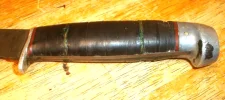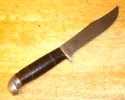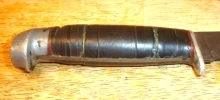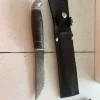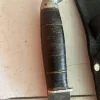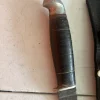BigAl62
Gold Member
- Joined
- Jan 22, 2024
- Messages
- 89
I have what I believe to be a West-Cut L44-5 from 1941 that I picked up in a flea market a few months ago. Zzyzzogoten identified it for me in another post although he clarified that the spacer pattern does not match his catalog pages. The leather disks are in pretty good shape except for the gaps at the brass spacers.
I've never really done any "work" on a knife but I'd like tighten it up - probably by adding some spacers? The first thing I did was to clean out all the green verdigris from the gaps with a toothpick, dental floss and a utility knife blade. Then I submerged the handle in Fiebing's 100% Pure Neatsfoot oil 3 times. Each time, I submerged it for maybe 10 minutes and then removed it and allowed it to dry for several days before repeating. This last time, it's been drying for a over a week. The handle is just as firm as the day I got it but no swell. The brass spacers will move around but the leather seems pretty well fixed in place. I don't want to force the leather any. It may or may not mean anything but the "middle" section seemed to absorb and dry pretty quickly while the oil seemed to sit on the surface of the 2 end sections and I finally had to wipe them dry.
I certainly don't want to mess up a nice knife. Any recomendations or even maybe someone who could fix it for me?
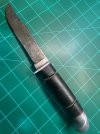
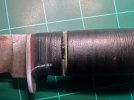
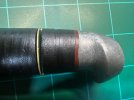
I've never really done any "work" on a knife but I'd like tighten it up - probably by adding some spacers? The first thing I did was to clean out all the green verdigris from the gaps with a toothpick, dental floss and a utility knife blade. Then I submerged the handle in Fiebing's 100% Pure Neatsfoot oil 3 times. Each time, I submerged it for maybe 10 minutes and then removed it and allowed it to dry for several days before repeating. This last time, it's been drying for a over a week. The handle is just as firm as the day I got it but no swell. The brass spacers will move around but the leather seems pretty well fixed in place. I don't want to force the leather any. It may or may not mean anything but the "middle" section seemed to absorb and dry pretty quickly while the oil seemed to sit on the surface of the 2 end sections and I finally had to wipe them dry.
I certainly don't want to mess up a nice knife. Any recomendations or even maybe someone who could fix it for me?



Last edited:

